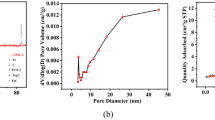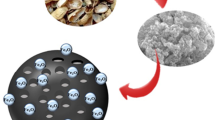Abstract
The efficient removal of phosphorous from water is an important but challenging task. In this study, we validated the applicability of a new commercially available nanocomposite adsorbent, i.e., a polymer-based hydrated ferric oxide nanocomposite (HFO-201), for the further removal of phosphorous from the bioeffluent discharged from a municipal wastewater treatment plant, and the operating parameters such as the flow rate, temperature and composition of the regenerants were optimized. Laboratory-scale results indicate that phosphorous in real bioeffluent can be effectively removed from 0.92 mg·L−1 to <0.5 mg·L−1 (or even<0.1 mg·L−1 as desired) by the new adsorbent at a flow rate of 50 bed volume (BV) per hour and treatable volume of 3500–4000 BV per run. Phosphorous removal is independent of the ambient temperature in the range of 15°C–40°C. Moreover, the exhausted HFO-201 can be regenerated by a 2% NaOH + 5% NaCl binary solution for repeated use without significant capacity loss. A scaled-up study further indicated that even though the initial total phosphorus (TP) was as high as 2 mg·L−1, it could be reduced to <0.5 mg·L−1, with a working capacity of 4.4–4.8 g·L−1 HFO-201. In general, HFO-201 adsorption is a choice method for the efficient removal of phosphate from biotreated waste effluent.
Similar content being viewed by others
References
Jing X C. Technologies for Lake Eutrophication Control and Management. Beijing: Chemical Industry Press, 2001, 238–239 (in Chinese)
Schindler D W. Evolution of phosphorus limitation in lakes. Science, 1977, 195(4275): 260–262
Meng H M, Zhang Z K. Assessment on eutrophication of main reservoirs in China. Journal of Henan Normal University (Natural Science edition), 2007, 35(2): 133–137 (in Chinese)
General Administration of Quality Supervision of the People’s Republic of China. The State Standards of Integrated Wastewater Discharge (GB 8978-1996). Beijing: China Environmental Science Press, 1996 (in Chinese)
US EPA. Quality standards regulations and federally promulgated standards, available online at http://water.epa.gov/scitech/swguidance/standards/wqsregs.cfm (accessed August 10, 2012)
Seida Y, Nakano Y. Removal of phosphate by layered double hydroxides containing iron. Water Research, 2002, 36(5): 1306–1312
Yamada H, Kayama M, Saito K, Hara M. A fundamental research on phosphorus removal by using slag. Water Research, 1986, 20(5): 547–557
Liu L N, Liu Z M, Wu D Y. Preliminary study on phosphorus removal from urban landscape water by fly ash. Environmental Science & Technology, 2006, 29(2): 40–42 (in Chinese)
Chen X J, Xiao J Q. Research process of phosphate removal from wastewater. Gansu Science and Technology, 2004, 20(3): 102–103 (in Chinese)
van LoosdrechtMC M, Hooijmans CM, Brdjanovic D, Heijnen J J. Biological phosphate removal processes. Applied Microbiology and Biotechnology, 1997, 48(3): 289–296
Oehmen A, Lemos P C, Carvalho G, Yuan Z G, Keller J, Blackall L L, Reis M A M. Advances in enhanced biological phosphorus removal: from micro to macro scale. Water Research, 2007, 41(11): 2271–2300
De Vicente I, Huang P, Andersen F O, Jensen H S. Phosphate adsorption by fresh and aged aluminum hydroxide. Consequences for lake restoration. Environmental Science & Technology, 2008, 42(17): 6650–6655
Onyango M S, Kuchar D, Kubota M, Matsuda H. Adsorptive removal of phosphate ions from aqueous solution using synthetic zeolite. Industrial & Engineering Chemistry Research, 2007, 46(3): 894–900
de-Bashan L E, Bashan Y. Recent advances in removing phosphorus from wastewater and its future use as fertilizer (1997–2003). Water Research, 2004, 38(19): 4222–4246
Wang X M, Hou Y L. Effects of organic matter addition on the characteristics of phosphate adsorption and forms of phosphorus in a calcareous soil. Acta Scientiae Circumstantiae, 2004, 24(3): 440–443 (in Chinese)
Xiong H B, Liu W Q. Study on phosphate removal of high-concentration phosphorus-containing wastewater by calcium precipitation. Technology of Water Treatment, 2004, 12(3): 240–243 (in Chinese)
Converti A, Rovatti M, Borghi M D. Biological removal of phosphorus from wastewaters by alternating aerobic and anaerobi conditions. Water Research, 1995, 29(1): 263–269
Wang L, Li J, Kang W L, Huang C. Review on the biological removal of phosphorus in wastewater. Environmental Pollution & Control, 2006, 28(5): 348–351 (in Chinese)
Parsons S A, Smith J A. Phosphorus removal and recovery from municipal wastewaters. Elements, 2008, 4(2): 109–112
Ding W M. Progress of studies on phosphorus removal from wastewater by adsorbents. Techniques and Equipment for Environmental Pollution, 2002, 3(10): 23–27 (in Chinese)
Saha B, Chakraborty S, Das G. A mechanistic insight into enhanced and selective phosphate adsorption on a coated carboxylated surface. Journal of Colloid and Interface Science, 2009, 331(1): 21–26
Chitrakar R, Tezuka S, Sonoda A, Sakane K, Ooi K, Hirotsu T. Selective adsorption of phosphate from seawater and wastewater by amorphous zirconium hydroxide. Journal of Colloid and Interface Science, 2006, 297(2): 426–433
Wassay S A. Adsorption of fluoride, phosphate, and arsenate ions on lanthanum-impregnated silica gel. Water Environment Research, 1996, 68(3): 295–300
Ryden J C, Mclaughlin J R, Syers J K. Mechanisms of phosphate sorption by soils and hydrous ferric-oxide gel. Journal of Soil Science, 1977, 28(1): 72–92
Khare N, Hesterberg D, Martin J D. XANES investigation of phosphate sorption in single and binary systems of iron and aluminum oxide minerals. Environmental Science & Technology, 2005, 39(7): 2152–2160
Jang M, Chen W F, Cannon F S. Preloading hydrous ferric oxide into granular activated carbon for arsenic removal. Environmental Science & Technology, 2008, 42(9): 3369–3374
Zhang N, Lin L S, Gang D C. Adsorptive selenite removal from water using iron-coated GAC adsorbents. Water Research, 2008, 42(14): 3809–3816
Xiong W H, Peng J. Development and characterization of ferrihydrite-modified diatomite as a phosphorus adsorbent. Water Research, 2008, 42(19): 4869–4877
Cumbal L, Sengupta A K. Arsenic removal using polymersupported hydrated iron(III) oxide nanoparticles: role of donnan membrane effect. Environmental Science & Technology, 2005, 39(17): 6508–6515
Blaney L M, Cinar S, SenGupta A K. Hybrid anion exchanger for trace phosphate removal from water and wastewater. Water Research, 2007, 41(7): 1603–1613
Pan B C, Chen X Q, Zhang W M, Pan B J, Shen W, Zhang Q J, Du W, Zhang Q X, Chen J L. A process to prepare a polymer-based hybrid sorbent for arsenic removal. Chinese Patent, 2005, No.: ZL 2005 1 0095177.5
Pan B C, Zhang Q J, Chen X Q, Zhang W M, Pan B J, Zhang Q X. Preparation of resin-based hydrated ferric oxides based on Donnan membrane effect and research on its adsorption capacity on arsenate. Scientia Sinica Chimica, 2007, 37(5): 426–431 (in Chinese)
Pan B J, Wu J, Pan B C, Lv L, Zhang W M, Xiao L L, Wang X S, Tao X C, Zheng S R. Development of polymer-based nanosized hydrated ferric oxides (HFOs) for enhanced phosphate removal from waste effluents. Water Research, 2009, 43(17): 4421–4429
Dawson M V, Lyle S J. Spectrophotometric determination of iron and cobalt with Ferrozine and dithizone. Talanta, 1990, 37(12): 1189–1191
Su C M, Puls R W. Arsenate and arsenite removal by zerovalent iron: effects of phosphate, silicate, carbonate, borate, sulfate, chromate, molybdate, and nitrate, relative to chloride. Environmental Science & Technology, 2001, 35(22): 4562–4568
Minstry of Environmental Protection of the People’s Republic of China. Water Quality-Determination of Ammonia Nitrogen-Nessler’s Reagent Spectrophotometry. Beijing: China Environmental Science Press, 2009 (in Chinese)
Minstry of Environmental Protection of the People’s Republic of China. Water Quality-Determination of Inorganic Anions-Ion Chromatography Method. Beijing: China Environmental Science Press, 2001 (in Chinese)
Zeng H, Fisher B, Giammar D E. Individual and competitive adsorption of arsenate and phosphate to a high-surface-area iron oxide-based sorbent. Environmental Science & Technology, 2008, 42(1): 147–152
Prevette L E, Kodger T E, Reineke T M, Lynch M L. Deciphering the role of hydrogen bonding in enhancing pDNA-polycation interactions. Langmuir, 2007, 23(19): 9773–9784
Sabbatini N, Perathoner S, Lattanzi G, Dellonte S, Balzani V. Electron- and energy-transfer processes involving exited states of lanthanide complexes: evidence for innersphere and outer-sphere mechanisms. Inorganic Chemistry, 1988, 27(9): 1628–1633
Manjari S R, Kim H J. Temperature- and pressure-dependence of the outer-sphere reorganization free energy for electron transfer reactions: a continuum approach. The Journal of Physical Chemistry B, 2006, 110(1): 494–500
Author information
Authors and Affiliations
Corresponding author
Rights and permissions
About this article
Cite this article
Hua, M., Xiao, L., Pan, B. et al. Validation of polymer-based nano-iron oxide in further phosphorus removal from bioeffluent: laboratory and scaledup study. Front. Environ. Sci. Eng. 7, 435–441 (2013). https://doi.org/10.1007/s11783-013-0508-1
Received:
Accepted:
Published:
Issue Date:
DOI: https://doi.org/10.1007/s11783-013-0508-1




